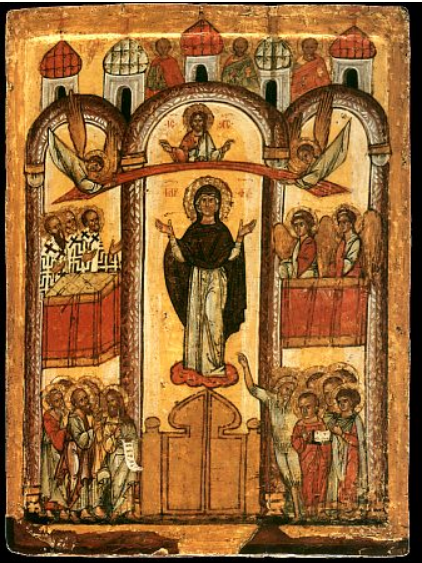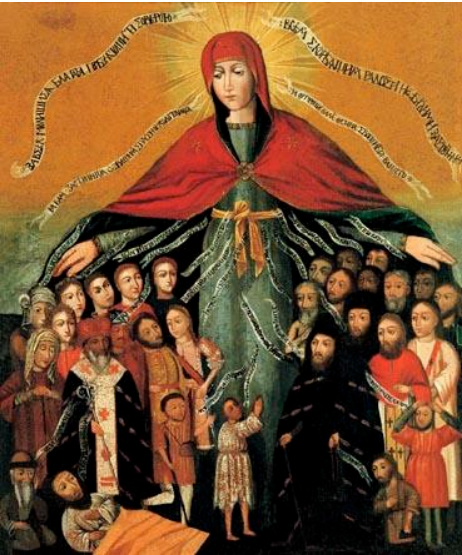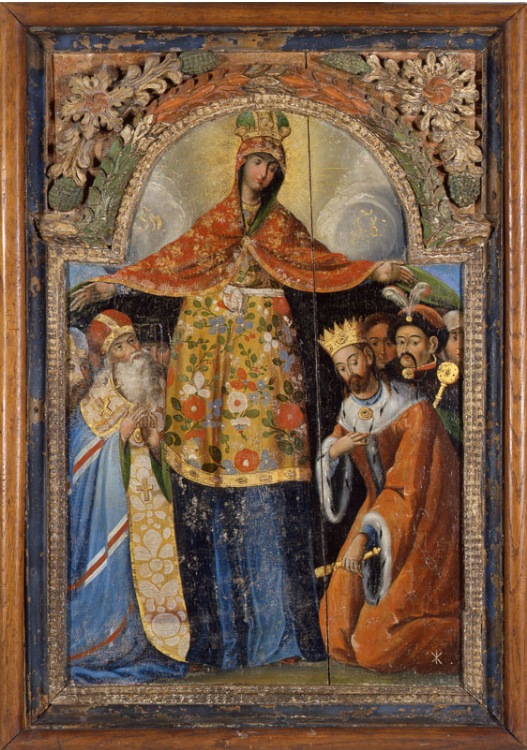
| Version | Summary | Created by | Modification | Content Size | Created at | Operation |
|---|---|---|---|---|---|---|
| 1 | Sirius Huang | -- | 1375 | 2022-11-24 01:43:53 |
Video Upload Options
The Intercession of the Theotokos, or the Protection of Our Most Holy Lady Theotokos and Ever-Virgin Mary, is a feast of the Mother of God celebrated in the Eastern Orthodox and Byzantine Catholic Churches. The feast celebrates the protection afforded the faithful through the intercessions of the Theotokos (lit. Mother of God, the Eastern title of the Virgin Mary). In the Slavic Orthodox Churches it is celebrated as the most important solemnity besides the Twelve Great Feasts and Pascha. The feast is commemorated in Eastern Orthodoxy as a whole, but by no means as fervently as it is in Russia , Belarus and Ukraine . It is not a part of the ritual traditions of, and therefore is not celebrated by, the Oriental Orthodox Churches or some jurisdictions that allow Western Rite Orthodoxy. Yet the feast is perfectly consistent with the theology of these sister churches. It is celebrated on October 14 (OS October 1). The Western Rite Communities of the Russian Orthodox Church Outside of Russia (ROCOR) do celebrate this feast on their calendar.
1. Etymology
The Protection of the Theotokos or the Intercession of the Theotokos (Template:Lang-cu, Pokrov, Ukrainian: Покрова, Pokrova), like the (Greek: Σκεπή, Skepḗ) has a complex meaning. First of all, it refers to a cloak or shroud, but it also means protection or intercession. For this reason, the name of the feast is variously translated as the Veil of Our Lady, the Protecting Veil of the Theotokos. It is often translated as Feast of the Intercession or Feast of the Holy Protection.
With some reservations, the Pokrov icon may be related to the Western Virgin of Mercy image, in which the Virgin spreads wide her cloak to cover and protect a group of kneeling supplicants (first known from Italy from about 1280).
2. Tradition


According to Eastern Orthodox Sacred Tradition, the apparition of Mary the Theotokos occurred during the 10th century at the Blachernae church in Constantinople (modern-day Istanbul) where several of her relics (her robe, veil, and part of her belt) were kept. On Sunday, October 1 at four in the morning, St. Andrew the Blessed Fool-for-Christ, who was a Slav by birth, saw the dome of the church open and the Virgin Mary enter, moving in the air above him, glowing and surrounded by angels and saints. She knelt and prayed with tears for all faithful Christians in the world. The Virgin Mary asked Her Son, Jesus Christ, to accept the prayers of all the people entreating Him and looking for Her protection. Once Her prayer was completed, She walked to the altar and continued to pray. Afterwards, She spread Her veil over all the people in the church as a protection.[1]
St. Andrew turned to his disciple, St. Epiphanius, who was standing near him, and asked, "Do you see, brother, the Holy Theotokos, praying for all the world?" Epiphanius answered, "Yes, Holy Father, I see it and am amazed!"[1]
According to the Primary Chronicle of St. Nestor the Chronicler, the inhabitants of Constantinople called upon the intercession of the Mother of God to protect them from an attack by a large Rus' army (Rus' was still pagan at the time). According to Nestor, the feast celebrates the destruction of this fleet sometime in the ninth century.
3. Icon
The icon of the feast, which is not found in Byzantine art, depicts in its upper part the Virgin Mary surrounded by a luminous aureole. She holds in her outstreched arms an orarion or veil, which symbolizes the protection of her intercession.[2] To either side of her stand numerous saints and angels, many of whom are recognizable to the experienced church-goer: the apostles, John the Baptist, St. Nicholas of Myra, etc. Below, St. Andrew the Fool for Christ is depicted, pointing up at the Virgin Mary and turning to his disciple Epiphanius. Usually, the veil with which the Virgin protects mankind is small and held either in her outstretched hands or by two angels,[3] though a version similar to the Western European Virgin of Mercy image, with a larger cloak covering people is found in some Eastern Orthodox icons.
4. Feast

The Feast of the Intercession commemorates the miracle as a joyous revelation of the Theotokos' protection, which is spread over the world, and the Mother of God’s great love for mankind.[4] It is a religious holy day or feast day of the Byzantine Rite Eastern Orthodox Churches.[1][5] It is not found in Oriental Orthodoxy nor some jurisdictions of Western Rite Orthodoxy though it is perfectly consistent with the theology and beliefs of these sister churches. It is held annually on October 14, which corresponds to October 1 on the "Old Style calendar" i.e. the Julian calendar still used in some Eastern Orthodox Churches. It is served as an All-Night Vigil, with many of the same elements as occur on Great Feasts of the Theotokos. However, Pokrov has no Afterfeast. The Western Rite Communities of the Russian Orthodox Church Outside of Russia (ROCOR) do celebrate this feast on their calendar. (www.rocor-wr.org)
Some, but not all, regions of the Russian Federation celebrate the Feast of Intercession as a work holiday. In Ukraine , it is celebrated on October 14 as a religious, national, and family holiday.[5] The Mother of God as the Intercessor and Patron became firmly established among Ukrainians: princes, kings, cossacks, and hetmans chose the Mother of God as their patroness and protectress. An icon in the National Art Museum of Ukraine shows the Virgin Mary protecting the Ukrainian cossack hetman Bohdan Khmelnytsky. By decree of the Ukrainian President, October 14 — Pokrova Feast Day was promulgated also as Ukrainian Cossack Day (Ukrainian: День Українського козацтва).[6]
October 1 (in the Julian calendar) is also the feast of St. Romanus the Melodist, so he is often depicted on the same icon, even though he and St. Andrew lived at different times. He is often shown directly below the Virgin Mary, standing on a bema, or on a kathedra, chanting from a scroll.[3] The scroll represents the various kontakia which have been attributed to him.
The feast day of St. Andrew, the Fool-for-Christ, falls on the following day, October 2 (in accordance with the Orthodox liturgical tradition of the Synaxis).
5. Churches Dedicated to Pokrov

Many Orthodox churches worldwide are named after this feast. The first churches dedicated to feast of Pokrov appeared in Russia in the 12th century. Probably the most famous Russian church named for the feast day is Saint Basil's Cathedral, Red Square, Moscow, which is officially entitled "the Church of Intercession of Our Lady that Is on the Moat" (Russian: Собор Покрова пресвятой Богородицы, что на Рву) or shortly "Intercession Cathedral upon moat" (Russian: Храм Покрова "на рву").[7] The other one is the Church of Intercession in Bogolyubovo near Vladimir on the Nerl River (Russian: Церковь Покрова на Нерли, Tserkov Pokrova na Nerli). Both churches are on the United Nations ' World Heritage List, the latter as part of the site White Monuments of Vladimir and Suzdal. There is also a Church of the Intercession of the Holy Virgin in St. Petersburg.[8]
Other notable churches commemorating this feast are Intercession of the Holy Virgin Russian Orthodox Church in Manchester, England,[9] and the Russian Orthodox Church of the Intercession of the Holy Virgin & St. Sergius in Glen Cove, New York.
Saint Mary the Protectress in Irondequoit, New York is a notable Ukrainian Orthodox Church dedicated to the feast of Pokrova. A great many Ukrainian churches are also named in honour of this feast in Canada.[2]
In north Wales there is the Church of the Holy Protection (Eglwys yr Amddiffyniad Sanctaidd) at 10 Manod Road, Blaenau Ffestiniog, where the liturgy is celebrated partly in Welsh, also English, Greek, and Church Slavonic. The church, under Archimandrite Deiniol, is under the omophor the Ukrainian Orthodox Church of the diocese of Western Europe under the Ecumenical Patriarch. Previously it belonged to the Belarusian Autocephalous Orthodox Church, and previous to that to the Diocese of Sourozh of the Moscow Patriarchate.
References
- "Holy Protection of the Virgin Mary". Protection of the Blessed Virgin Mary Ukrainian Catholic Church. http://www.protectionbvmsolon.com/.
- Demchinsky, Sterling. "Icons of the Theotokos (Bohoroditsia)". Ukrainian Churches of Canada. http://www.ukrainianchurchesofcanada.ca/iconography/uf_Theotokos.html.
- Neil K. Moran; Singers in Late Byzantine and Slavonic Painting, p. 126ff, Brill, 1986, ISBN:90-04-07809-6 https://books.google.co.uk/books?id=3dcUAAAAIAAJ&pg=PA128&dq=pokrov+icon&lr=&sig=ACfU3U1N6OmsFbF6o5ogi4_a8vX4AJEBCA#PPA126,M1
- "Protection of the Holy Virgin", Tranfiguration of Our Laord Russian Orthodox Church, Baltimore, Maryland http://www.holy-transfiguration.org/library_en/moth_protection.html
- "Feast of Intercession Celebrated in Ukraine as Religious and National Holiday". RISU - Religious Information Service in Ukraine. 14 October 2012. http://risu.org.ua/en/index/all_news/culture/religious_holidays/49887/.
- "Про День Українського козацтва Президент України; Указ від 07.08.1999 № 966/99". Verkhovna Rada of Ukraine. 7 August 1999. http://zakon1.rada.gov.ua/laws/show/966/99.
- Shvidkovsky, D. S. (2007). Russian architecture and the West. Yale University Press. ISBN 978-0300109122. https://books.google.com/books?id=LQy9TJ2yOQEC. p. 126.
- St. Petersburg website. Accessed February 7, 2010. http://www.saint-petersburg.com/churches/church-intercession-holy-virgin-polytechnic-institute.asp
- Pokrov Church of the Russian Orthodox church website from UK. Accessed February 7, 2010. http://www.pokrov.org.uk/




